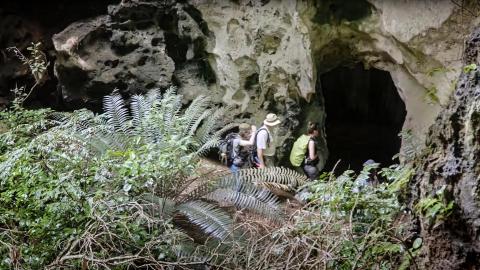Discovered: 78,000 years ago, the oldest known burial ritual in Africa

Photo by Francesco Derrico & Alain Queffelec / AFP via Getty Images
- The oldest known burial ritual in Africa has been discovered on the coast of Kenya.
- A small child appears to have been buried intentionally in a cave 78,000 years ago.
- This new research offers insights into ancient funerary practices.
How did the emergence of Homo sapiens affect ideas around death? What legacies have been passed down from ancient times? And can these give us insights into the origins of our current rituals around dying?
Possible answers to these questions could be derived from a new study in Nature, led by María Martinón-Torres of the National Research Center on Human Evolution in Burgos, Spain. It focuses on a two- to three-year-old child found buried in a Kenyan cave roughly 78,000 years ago. While this isn’t the oldest burial grounds for Homo sapiens — to date, that is in Israel — this new discovery of a seemingly intentional burial offers insights into the evolution of how humans treated death.
The dearth of excavation sites in Africa has made studying ancient funerary practices difficult. The remains of this young child were discovered in a pit in the Panga ya Saidi cave site located in a tropical region of coastal Kenya. Taphonomic evidence, which examines the process of fossilization, suggested that the child was intentionally placed in a flexed position (sort of curled up like a ball) in the burial pit.
The burial of Mtoto
The original excavation of this pit took place in 2013. By 2017, archaeologists dug into Middle Stone Age (MSA) layers, uncovering the partial skeleton of the child. The poorly preserved bone fragments were plastered and transported for laboratory analysis, first to the National Museums of Kenya and then onto Burgos, where Martinón-Torres and her team began their work.
Besides the seemingly deliberate position of the body, the team noticed a few clues that suggested the child was swaddled in cloth, possibly with the intention of preserving the corpse. They also speculate the body was placed in a cave fissure — known as funerary caching — before being covered with sediment.

The child, who they named Mtoto, appears to have been intentionally buried. The authors reached this conclusion based on: the identification of a clearly dug pit; evidence that discriminates the burial fill from the surrounding layers; the completeness and integrity of the skeleton; the body’s tightly flexed position; and the notable differences between the child’s remains and the remains of animals in the same layer.
Other burial sites
Two earlier excavations in Taramsa, Egypt and Border Cave, South Africa were similar to the one in this Kenyan cave. However, the Panga ya Saidi remains appear to predate the Egyptian ones by 10,000 years and the South African ones by 4,000 years. Taken together, the team writes that these three digs reveal important insights in the funerary practices of our ancestors.
“The [Panga ya Saidi] child, in combination with the infant burial from Border Cave and the funerary caching of a juvenile at Taramsa, suggests that H. sapiens populations were intentionally preserving the corpses of young members of their groups between about 78 and 69 [thousand years]. Before 78 [thousand years], we know of no unambiguous burials of modern humans in Africa, despite the fact that earlier [Middle Stone Age] populations demonstrate sophisticated forms of symbolic expression.”
The researchers are excited to have made headway on the cradle of civilization — a continent that rarely gives up its secrets. While researchers have discovered symbolic representations in Africa dating back at least 320,000 years, these new insights into death rituals are important for understanding the evolution of human consciousness, as well as how we view mortality.
—
Stay in touch with Derek on Twitter and Facebook. His most recent book is “Hero’s Dose: The Case For Psychedelics in Ritual and Therapy.”





